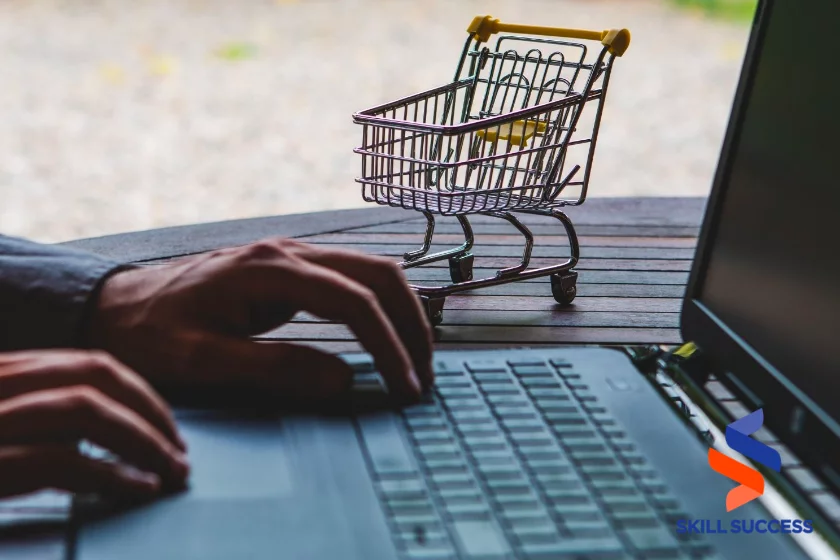If you’re an artisan or an avid crafter looking for an eCommerce platform where you can sell handmade products to an interested customer base, Etsy is the perfect place for you.
It’s likely that you’ve heard about the platform before, but don’t know as much about it as its more popular counterparts like Amazon, Craigslist, and eBay. Well, in this article, you’ll learn all about how to sell on Etsy—where 95% of every sale that your handmade goodies make goes back to you.
What is Etsy?
Etsy is an online marketplace connecting sellers worldwide with buyers searching for unique handmade goods. From bracelets to necklaces, rings, earrings, and more, Etsy is perfect for anyone who is creative and wants to sell their handmade or vintage items.
Aside from physical items, digital goods such as blog themes, website designs, and Canva templates are available on the platform.
Etsy is a community of innovators, risk-takers, and pioneers. If you dream of starting your own small business or working from home, Etsy is the place to be. You'll find all the tools to turn your good ideas into reality, from online shopping to payment processing to shipping labels.
How does selling on Etsy work?
Etsy is the go-to site for many artisans. In fact, Etsy's mission is to "keep commerce human" by providing a platform that empowers individuals to start their own businesses. It offers exposure and independence to its sellers, who are mostly small business owners.
The way Etsy works is that you list your products in the marketplace. Sellers can post listings for free and are charged $0.20 per listing. Listings stay active for four months or until the item is sold. The seller can renew the listing after that time.
If you're thinking about opening an Etsy shop but unsure how the process works, the following guide is for you. We'll cover everything you need to know about selling on Etsy: how to open your shop and set up listings, what kinds of things you can sell, how much it will cost, and more.
A step-by-step guide to selling on Etsy
When you sell on Etsy, you'll become a part of their community of independent sellers. You'll set up your online shop, choose between one of three selling plans, and pay a small listing fee for each item you post for sale.
This guide walks you through registering for a seller account, setting up your payment account, creating product listings, and managing orders.
If you want to sell on Etsy, follow these steps:
1. Register for an Etsy account
When you register for an account on Etsy, you'll be asked if you want to open a shop. Click "Open Shop" to get started or learn more about how it works.
2. Create your Etsy Store
To sell on Etsy, the next step is to open your Etsy store. Go to the Etsy homepage and click "Sell on Etsy" to get started. You'll be redirected to a new window and be guided through the process of setting up your store's settings, including selecting a name for your shop.
It’s also highly recommended to read through their selling help center to know more about their policies and requirements.
3. Choose a shop name and other preferences
You'll add a name for your online shop here. Keep it short and sweet—it should be between four and 20 characters, without spaces or special characters.
Select a name that reflects your style and matches the products you sell. Selecting keywords for listing preferences will help potential buyers find what they are looking for when searching Etsy's site.
You need to also provide your preferred currency on your shop, country of residence, and your shop's language.
4. Stock your shop
In this section of the registration, you'll need to add at least one listing to your Etsy Shop.
Photos and Videos
This is where Etsy gives its sellers the visual merchandising edge: they provide you a list of photo angles you can add and a section for video uploads.
You can also browse through their list of requirements and tips for images and videos.
About the Listing
After providing the visuals of your listing, it's time to fill up the listing content. The details you'll need to include are:
- Listing Title - For the item title, you need to include keywords that you think buyers would use when they search for your item
- About the item - In this section, you'll need to provide who made the item, its purpose, and when you made it.
- Category of the item - Categories are two- or three-word descriptions of your item to get category suggestions. This will provide more visibility to your item and help shoppers find it.
- Renewal options for the item - Since Etsy charges $0.20 per listing that lasts up to four months, you can set the charge to automatic renewal or manual option.
- Listing Type - Categorize the listing if it's a physical or digital item
- Description of the item - When you're creating your item description, try to include an opening that sums up what the piece means to you or how you came to make it. Shoppers will only see the first few lines of your description at first, so make it count!
- Tags related to the item - You can add 13 tags that will help shoppers find your listing on Etsy
- Materials used for the creation or production of the item
Shipping and Inventory
In this section, you’ll need to input your listing’s inventory and set the shipping policies.
Shipping is a significant part of your Etsy shop. If you don't have a plan to fulfill orders, you can't expect your business to succeed. But the process can often feel overwhelming, especially when you're just starting out. From estimating the postage cost for your first Etsy listing to packing up a fragile order, early shipping experiences can often feel like a guessing game.
Here are some tips to help you out when setting your shop's shipping policies:
- For sellers based in United States and Canada, you can set-up Etsy’s calculated shipping. With calculated shipping, you can save time and set things up so that Etsy will pre-fill your shipping labels with each order’s weight, dimensions, and mail class.
- Take into account and calculation the packing materials you’re going to use to ship your items.
- Set-up shipping profiles to make it easier to edit your listings’ shipping information by bulk.
5. Set up your payment account
The next step is setting up your payment and billing information to receive payments from buyers. Make sure to verify your email address first before proceeding to this step!
To receive payments from Etsy, you'll need to provide your personal information such as Full Name and Home Address, Tax ID number, and Bank Details.
After providing the information needed, you'll need to verify your identity with an official government-issued ID from your country of residence. Ensure that the ID photo is clear and all information matches the details you provided earlier.
6. Set up billing information
To pay for Etsy's fees, you'll need to set up your billing information and save your credit card information.
It's free to open a shop, but every listing incurs a listing fee of $0.20. When an item sells, there's a transaction fee of 3.5% of the item's price (5% for digital goods). You can also purchase a subscription for a monthly payment that gives you access to additional tools, like promotional features and a dashboard to track your sales, listings, and shop statistics.
There will be no upfront fees to be charged when registering your shop. The charge will be due on the first day of the following calendar month.
After filling you the billing information, click Open Your Shop, and you will be redirected to your shop's homepage.
Learn how to sell on Etsy
If you need a more thorough guide on Etsy and the best selling practices to master, one of the best ways to get up to speed is by taking up online courses that focus on selling on Etsy.
Here in SkillSuccess, we provide a variety of courses that can take your online selling game to the next level:
Start An Etsy Business For Beginners
 Course Rating
5/5
Course Rating
5/5
If you've ever wanted to start an Etsy store but are unsure about where to start and what products to sell, this course will help you get started.
In this course, you'll learn the Etsy seller strategies for ranking your Etsy products to the top of search results. We'll cover everything from sourcing products to optimizing product listings. Learn the Etsy seller strategies, including where to start, what products to sell, how to source them, list them on Etsy, and how to get your products ranking in the first position!
When you finish this course, you'll be able to develop a business plan that can help you take your first steps in starting your own successful Etsy store!
"I had previously failed at an Etsy shop, this class was so easy to follow and I can see all the mistakes I made with my previous shop. I highly recommend this for anyone starting an Etsy business and has no clue what they are doing."Take this course
Etsy Store - Income And Expenses Management
Course Rating 0/5
In this course, you will learn how to track, read, and manage all the financial information of your Etsy shop.
Most Etsy sellers track their finances through their Etsy shop's dashboard. However, since the dashboard can only show you a limited amount of information, this course will also show you how to use your Etsy payment account to get specific financial data such as fees and taxes.
After this course, you'll learn to understand what fees and taxes apply for each sale made on Etsy, make sense of the financial reports available in your Etsy shop, and read and analyze your finances to make sound decisions for your business.
We also have other courses that can help you navigate the world of e-commerce. Insights and learnings from these can help you gain more traction for your Etsy shop.
Take this courseTips in selling on Etsy
Selling on Etsy is like starting a brick-and-mortar business with fewer overheads. You need to find your niche, invest in some key supplies, and promote your shop before you start making sales.
Here are some tips and tricks to help you sell more on Etsy:
1. Start with great photos and videos
Etsy is an image-driven site, so your photos should be clean, clear, and well-lit. If you can't afford a fancy camera or lighting equipment, don't stress. You can take excellent images using just your smartphone, but there are a few things you need to keep in mind:
- Use natural light as much as possible. Etsy's product photography guide has some great tips on doing this correctly.
- Use a simple background when photographing jewelry or other small items. A piece of white poster board will work fine for small items, but if you're photographing more oversized items like clothes or furniture, try to photograph them outside against a tree or hedge.
- Take the photo from eye level while holding the camera steady to avoid blurry shots (use a tripod).
- Edit your photos using image-editing software Canva or GIMP, both free programs that will allow you to crop, adjust brightness, or even touch it up with branding.
You can also add videos to your listing. In their listing section, Etsy highlighted their July 2020 analysis of 5 million potential buyers and comparing results of those who viewed listing videos to those who did not, shoppers are more likely to purchase an item that includes a video feature.
So don't scrimp on high-quality media for your listings--it's worth the investment!
2. Set yourself apart from the crowd
What makes your items unique and special? Why should customers buy them instead of those made by someone else? Consider what makes your shop different from others.
You can start by making your shop content and branding cohesive. Stand out with branded content and assets and the tone of your texts. Other things to take into consideration are your shop's:
- Shop title - Here's a brief description of your Etsy shop, including the services or products you sell. Your title should be informative to customers on what they will find in your Etsy shop. Think carefully about choosing keywords that will best describe your business.
- Shop announcement - In this section, you can include your Etsy listings or any unique details that shoppers need to know when they visit your shop.
- Message to Buyers - As an Etsy seller, you can leave a short message for your buyer after they complete the purchase. You can also use this space to leave a short message for your potential customers when they download any of your digital products.
- Links - You can link your brand or company's existing social media accounts to your Etsy Store. This will make cross-posting your listings and sharing on social media platforms more accessible.
Don't forget to proofread your content and listings before going live. Professional and well-written product descriptions and content will do wonders for your shop.
3. Soak up all the advice you can find
Get familiar with the Etsy community, browse the forums, and read other sellers' blogs. There are lots of helpful selling guides on the Etsy website too. Take advantage of the wealth of information out there.
You can also explore different tutorials on Youtube and Etsy-focused courses to gain more in-depth knowledge and insight on selling on Etsy.
4. Crosspost and cross-market
Promoting your shop and listing outside of Etsy will help you get more sales on the platform, so don't neglect other marketing strategies just because you're selling there!
You can utilize your shop and brand's social media channels to cross-promote your products on Facebook, Instagram, or Twitter. You can hop in on the latest video trends and create your spin on it using your brand on Tiktok.
Paid advertisements on social media channels and search engines are also an excellent way to drive traffic to your store. Before spending advertising dollars for your shop, make sure to research the market and what your competitors are doing.
5. Don't forget your customer service
Etsy is such a special place for artisans to sell their goods because of its intimacy—sellers have a chance to interact with their customers on a level that would never happen in brick-and-mortar stores. So make sure you take advantage of those opportunities! Respond quickly to questions and messages, address your customers by their names, and sign cards by hand—little gestures can go a long way toward building loyalty among your customers.
Having impeccable customer service is a must-have for any brand and business. Especially now in our Information Age, a single video or post online detailing a negative review or customer service experience can break your business.
When potential customers inquire, respond promptly and politely. You can also craft different message templates that you can use for the different types of inquiries your Etsy shop receives. This way, it'll save you time crafting responses after one another so you can focus more on scaling your shop.
After-sales customer service is also essential, especially for Etsy shops with high customer retention potential, such as craft shops, supplies stores, etc. An excellent after-sales customer experience can keep your customers returning to your Etsy shop!
It is essential to use various methods to succeed in your Etsy shop. Patience, research, and planning are all key to the success of a business. It takes a lot of time for you to master each aspect of running an Etsy shop. With the Etsy selling guide and tips that have been listed above, you have a running start.
It can be daunting even to know where to start if you're starting in Etsy. There are so many things to figure out, and sometimes it feels like every time you start to get the hang of one thing, there's another lesson to learn.
But don't give up! It's possible to be successful in the Etsy community with a bit of guidance and a lot of hard work.


